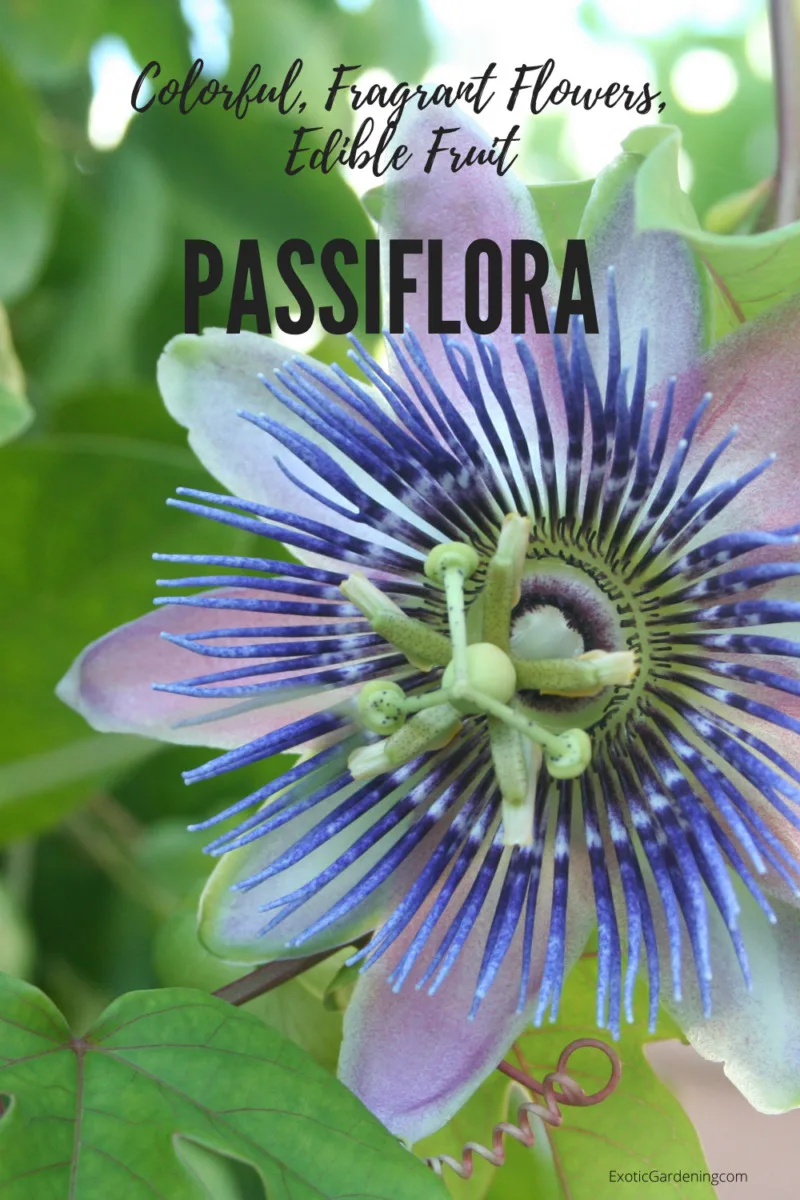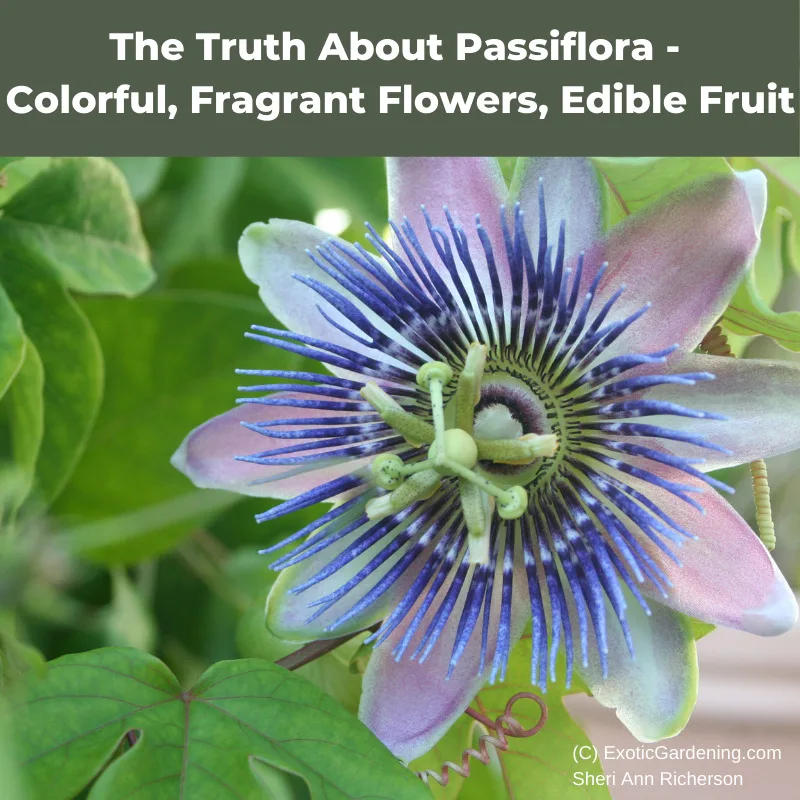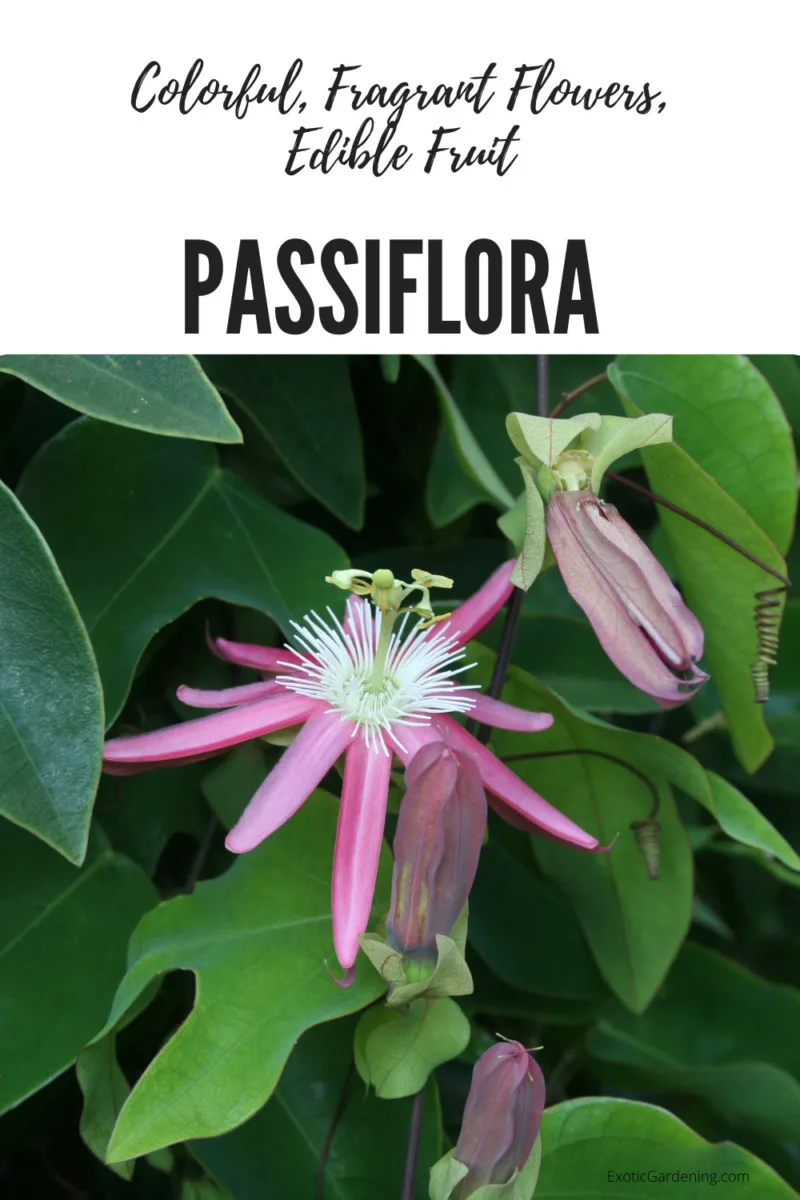According to legend, the Passion Flower (Passiflora spp.) was named by early Roman Catholic missionaries in South America because the flowers bore a fancied representation of the Passion of Christ.
Roman Catholic priests of the late 1500’s believed that several parts of the plant symbolized features of the Passion, the suffering and death of Jesus.
The ten apostles who remained faithful to Jesus throughout the Passion are represented by the five petals and the five petal-like sepals, while the hairlike rays above the petals were thought to represent the crown of thorns that Jesus wore.
The five stamens were thought to represent the wounds of Christ, while the pistils represented the nails.
These large, woody rapid growing vines cling to their supports with long tendrils and bear one-half inch to six inch wide flowers in a variety of colors, most commonly in shades of purples and reds, though some bear white, yellow, or blue flowers.
The majority of these plants are native to tropical, subtropical, and warmer temperate regions of North and South America.

Preferred Growing Conditions
Passiflora prefer a dormancy period in late fall or winter, although they will continue to grow and many will produce their famous one-day blooms year round.
They like to receive four hours or more of sunlight a day - although this may be provided by grow lights.
Ideal air conditions would be moist and humid.
Passiflora should also be repotted infrequently.
How To Get Them To Bloom Indoors
The trick to indoor blooming is to get the light close enough to the plant and bright enough to make it think it’s natural light without burning the leaves.
During their flowering and growing periods they prefer moist soil, however allowing them to dry slightly between waterings will not harm the plant.
How To Propagate Passiflora
Passiflora can be propogated either by seeds or cuttings.
Cuttings are the easiest, with blooms becoming possible within a few months.
Propogation with seed can be difficult, although it can be done with patience.

There Are Numerous Varieties To Choose From
- P. Alata (Winged stemmed passion flower) A free flowering variety from Spring till frost. 4-4.5" attractive, sweetly fragrant, carmine-crimson flowers produce a large edible fruit popular in Brazil. This Passiflora loves warm weather, and will not tolerate a frost at all.
- P. Ampullaceae (Cream passion flower) High in the Andes mountains of Ecuador to 13,000 ft., is the native home of this very rare and beautiful vine. It thrives in cooler temperatures from 45-80º F. This Passiflora bears exquisite tubular white flowers about 2" in diameter with cream colored petals.
- P. Antioquiensis (P. Van-Volxemii) Also known as the Red Banana Passion Flower. A lovely plant with large rose-red flowers that hang down. It produces a large banana shaped fruit that turns yellow when ripe and is quite delicious. This species will tolerate a slight frost, but the roots must not be allowed to freeze.
- P. Caerulea (The Blue Passion Flower) Very hardy to freezing but must grow back from the roots in spring. One of the most common passion flowers in the world originally from Brazil. The flower has white petals, with blue corona filaments up to 4" wide. Edible fruit is also produced with a bright orange skin and a rather tropical insipid taste.
- P. Capsularis (The capsule fruited passion flower) Grows 10-13 feet high. Similar to P. Rubra. Will tolerate a slight frost. Flowers are a greenish-white to pale yellow and are between 1" and 2 ¼" wide.
- P. Cinnabarina (The cinnabar red passion flower) Native to South East Australia, this showy red variety sports 2.5" flowers. Prefers temptures above 40º F., and humid conditions. Use a high potash fertilizer, being sure to avoid too much nitrogen. Misting the foliage during hot weather certainly helps this variety. This Passiflora will grow to 35 feet on a slim vine.
- P. Coccinea (The red granadilla) Native to Brazil, this Passiflora has very showy red 3-5" flowers with a white center. Exotic, tropical, and loves warm weather. Keep above 50º F.. A very vigorous vine for those who need to cover an arbor. Free flowering from mid-summer to autumn, and seeds from this variety germinate very easily.
- P. Edulis (The edible passion flower) Known as passion fruit the world over, it is commercially grown in many countries for juice. This is a very adaptable species that will tolerate mild frosts of no less than 28º F. There are many different sub-species of Edulis, although some of these will require hand-pollination if you want more fruit. More information on the subspecies is at the end of this list.
- P. Foetida (The goat scented passion flower) A fuzzy vined and leafed plant, with over 50 named varieties. A very vigorous plant that is hardy to 40º F. Easy to grow it bears beautiful white, pinkish or blue flowers followed by fruit that has a sweet-acid taste.
- P. Gilbertii A vigorous climber that is tolerant of a wide variety of conditions. Great for a cooler but frost protected environment, will take 30º F. for short periods. Fragrant 3" mauve and white flowers are produced profusely followed by a lot of fruit which is inedible.
- P. Gracilis (The annual Passion flower) The only annual passiflora, climbs on a slender vine to 6 feet during summer. This variety needs very little attention and will re-seed itself in spring. Small white flowers about 1" produce scarlet 1" long fruits.
- P. Incarnata (Maypop or May Apple) This passiflora is the only species indigenous to the U.S., one of the easiest to grow and has the best cold hardiness (to 15º on a mature plant!). Has large fragrant mauve and white flowers from June to November and sweet edible fruit. Also commonly used as a calming herbal tea. Very well drained soil that is fairly dry in winter is needed to prevent root rot. This is a very herbaceous vine and dies back every winter, only to pop back in May, hence the name Maypop!
- P. Kalbreyeri This species is from the Decaloba section, and is also a mountain species from the Andes of Venezuela. Flowers are about 1.5-2" and are purple to white. High temptures and humidity must be avoided and this vine is subject to over watering. Good air movement is vital as well as a sunny location. This variety is rare and hard-to-find.
- P. Ligularis This variety has beautiful fragrant flowers with speckled petals. This vine dislikes hot weather, does best in cooler climates (45-80ºf), and is not a good potted plant. It also requires two different seed plants to set fruit.
- P. Maliformis (Sweet Calabash) This beautiful vine is native to South America. Although it is very similar to P. Ligularis, this vine produces grape flavored fruit on a twenty foot vine. The flowers are fragrant with purple and white speckled petals. The shell of the fruit can be so hard you need a hammer to crack them open! This plant can take several years to produce fruit.
- P. Mollisima (The Banana passion flower) Native to higher mountain regions, his Passiflora prefers cooler less humid climates than most passiflora. This vine is a Tacsonia and germinates at cooler temps. Often grown just for the large banana shaped delicious fruit which tastes like an orange. The flowers are similar to Antioquiensis and are large and showy, pink to coral pink.
- P. Morifolia, A main source of food for the Heliconiinae butterflies. Grown all over the world, this vine is vigorous with a woody bulbous root. This plant does require a dormant period taken in the winter, and best to keep them dry at this time when in spring new shoots will appear from the root. Slight frost will not harm it if kept fairly dry. Flowers are greenish yellow or white and mauve about 1"
- P. Rubra (The red fruited passion flower) A vigorous slim vined plant to 15 feet. Very similar to Capsularis. This variety will not survive a frost down to the roots, but can be easily grown in a container. Free flowering summer to autumn with white or pale yellow petals to 2" . Produces abundant bright pink to red fruit.
- P. Seemannii A rather large vine and found usually only in private collections, this is a beautiful species with blue and white flowers 3-4" in size. This plant is not cold hardy at all with minimum temperature tolerance of 45 degrees F..
The Truth About Passiflora - Colorful, Fragrant Flowers, Edible Fruit - P. Quadrangularis (Giant Granadilla) This passion vine is truly the giant with huge flowers and the largest fruit of any passiflora. It is a large vine, and is very vigorous. The flowers can get up to 5" wide and the fruit can get up to 8 lb.. Best kept at 50 degrees F., but will tolerate lower temperatures if the soil is kept fairly dry.
- P. Zamoriana (Lilac Passion Flower) An extremely rare species from Ecuador, it is a mountain vine that prefers cooler conditions. From the Tacsonia section, best grown outdoors with partial shade in summer and then taken into a greenhouse or conservatory in winter where temptures should be kept at 40-55 degrees F.. Easy to germinate, but not easy to grow, and well worth the trouble. It is large flowered and may produce sweet fruit. The flowers are 5 ¼" wide and are deep salmon rose or lavender rose.
Passiflora edulis sub-species include:
- "Black Beauty" Large Black/Purple fruit with beautiful flowers
- "Purple Giant" Huge purple fruited variety resistant to many viruses.
- "Golden Giant" As the name implies, humungous sweet yellow fruit.
- "Gold Nugget" Yellow fruited variety resistant to viruses, good tasting fruit.
- "Panama Gold" Yellow fruited with good disease resistance. Tasty.
- "Panama Red" Red fruited delicious taste, good resistance to disease.
So, as you see, there are many different colors and varieties of this beautiful exotic vine.
This is one plant that I would highly suggest that you grow, even if its only during the summer months.

